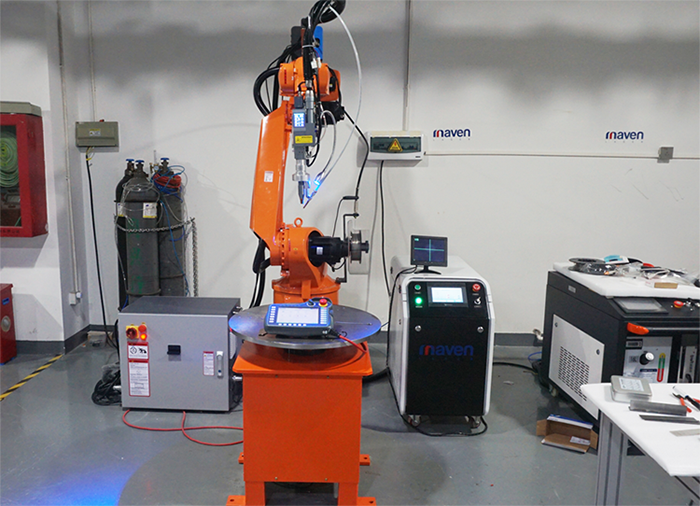Industrial robots are widely used in industrial manufacturing, such as automobile manufacturing, electrical appliances, food, etc. They can replace repetitive mechanical operations and are machines that rely on their own power and control capabilities to achieve various functions. It can withstand human command and can also operate according to pre-programmed programs. Now we talk about the basic main components of industrial robots.
1.Subject
The main machinery is the machine base and the actuating mechanism, including the big arm, forearm, wrist and hand, which constitute a multi-degree-of-freedom mechanical system. Some robots also have walking mechanisms. Industrial robots have 6 degrees of freedom or even more. The wrist generally has 1 to 3 degrees of freedom of movement.
2. Drive system
The driving system of industrial robots is divided into three categories according to the power source: hydraulic, pneumatic and electric. These three types can also be combined into a composite drive system based on requirements. Or indirectly driven through mechanical transmission mechanisms such as synchronous belts, gear trains, and gears. The drive system has a power device and a transmission mechanism, which are used to implement the corresponding actions of the mechanism. Each of these three types of basic drive systems has its own characteristics. The current mainstream is the electric drive system. Due to low inertia, large torque AC and DC servo motors and their supporting servo drives (AC frequency converters, DC pulse width modulators) are widely used. This type of system does not require energy conversion, is easy to use, and has sensitive control. Most motors require a delicate transmission mechanism: a reducer. Its teeth use a gear speed converter to reduce the number of reverse rotations of the motor to the required number of reverse rotations and obtain a larger torque device, thereby reducing the speed and increasing the torque. When the load is large, the servo motor is blindly increased The power is very cost-effective, and the output torque can be increased through a reducer within a suitable speed range. Servo motors are prone to heat and low-frequency vibration when operating at low frequencies. Long-term and repetitive work is not conducive to ensuring accurate and reliable operation. The existence of the precision reduction motor allows the servo motor to operate at a suitable speed, strengthening the rigidity of the machine body and outputting greater torque. There are two mainstream reducers today: harmonic reducer and RV reducer.
3.Control system
The robot control system is the brain of the robot and the main factor that determines the functions and functions of the robot. The control system sends command signals to the driving system and execution mechanism according to the input program, and controls them. The main task of industrial robot control technology is to control the range of activities, posture and trajectory, and action time of industrial robots in the work space. It has the characteristics of simple programming, software menu operation, friendly human-computer interaction interface, online operation prompts and convenient use. The controller system is the core of the robot, and relevant foreign companies are closely closed to our experiments. In recent years, with the development of microelectronics technology, the performance of microprocessors has become higher and higher, and the price has become cheaper and cheaper. Now, 32-bit microprocessors costing 1-2 US dollars have appeared on the market. Cost-effective microprocessors have brought new development opportunities to robot controllers, making it possible to develop low-cost, high-performance robot controllers. In order to make the system have sufficient computing and storage capabilities, robot controllers are now mostly composed of powerful ARM series, DSP series, POWERPC series, Intel series and other chips. Since the functions and functions of existing general-purpose chips cannot fully meet the requirements of some robot systems in terms of price, functionality, integration and interfaces, this has given rise to the demand for SoC (System on Chip) technology in robot systems. The processor is integrated with the required interfaces, which can simplify the design of system peripheral circuits, reduce system size, and reduce costs. For example, Actel integrates NEOS or ARM7 processor cores into its FPGA products to form a complete SoC system. In terms of robot technology controllers, its research is mainly concentrated in the United States and Japan, and there are mature products, such as the American DELTATAU Company, Japan's Pengli Co., Ltd., etc. Its motion controller takes DSP technology as its core and adopts a PC-based open structure. 4. End effector The end effector is a component connected to the last joint of the manipulator. It is generally used to grab objects, connect with other mechanisms and perform required tasks. Robot manufacturers generally do not design or sell end effectors; in most cases, they only provide a simple gripper. Usually the end effector is installed on the 6-axis flange of the robot to complete tasks in a given environment, such as welding, painting, gluing, and parts loading and unloading, which are tasks that require robots to complete.
Overview of servo motors Servo driver, also known as "servo controller" and "servo amplifier", is a controller used to control servo motors. Its function is similar to that of a frequency converter on ordinary AC motors, and it is part of the servo system. Generally, the servo motor is controlled through three methods: position, speed and torque to achieve high-precision positioning of the transmission system.
1. Classification of servo motors It is divided into two categories: DC and AC servo motors.
AC servo motors are further divided into asynchronous servo motors and synchronous servo motors. At present, AC systems are gradually replacing DC systems. Compared with DC systems, AC servo motors have the advantages of high reliability, good heat dissipation, small moment of inertia, and the ability to operate under high pressure. Because there are no brushes and steering gears, the AC servo system also becomes a brushless servo system, and the motors used in it are cage-type asynchronous motors and permanent magnet synchronous motors with a brushless structure. 1) DC servo motors are divided into brushed and brushless motors
① Brushed motors have low cost, simple structure, large starting torque, wide speed range, easy control, require maintenance, but are easy to maintain (replace carbon brushes), produce electromagnetic interference, have requirements on the use environment, and are usually used for cost control Sensitive general industrial and civil situations;
② Brushless motors are small in size and light in weight, with large output and fast response. They have high speed and small inertia, stable torque and smooth rotation. The control is complex and intelligent. The electronic commutation method is flexible. It can commutate with square wave or sine wave. The motor is maintenance-free and efficient. Energy saving, small electromagnetic radiation, low temperature rise and long life, suitable for various environments.
2. Characteristics of different types of servo motors
1) Advantages and disadvantages of DC servo motor Advantages: precise speed control, very hard torque and speed characteristics, simple control principle, easy to use, and cheap price. Disadvantages: brush commutation, speed limit, additional resistance, generation of wear particles (not suitable for dust-free and explosive environments)
2) Advantages and disadvantages of AC servo motor Advantages: good speed control characteristics, smooth control in the entire speed range, almost no oscillation, high efficiency of more than 90%, less heat generation, high-speed control, high-precision position control (depending on the encoder accuracy), rated operating area Within, it can achieve constant torque, low inertia, low noise, no brush wear, and maintenance-free (suitable for dust-free and explosive environments). Disadvantages: The control is more complicated, the driver parameters need to be adjusted on-site and the PID parameters are determined, and more connections are required. Currently, mainstream servo drives use digital signal processors (DSP) as the control core, which can implement relatively complex control algorithms and achieve digitization, networking and intelligence. Power devices generally use drive circuits designed with intelligent power modules (IPM) as the core. The IPM integrates the drive circuit and has fault detection and protection circuits such as overvoltage, overcurrent, overheating, and undervoltage. Software is also added to the main circuit. Start circuit to reduce the impact of the startup process on the driver. The power drive unit first rectifies the input three-phase power or mains power through a three-phase full-bridge rectifier circuit to obtain the corresponding direct current. The rectified three-phase power or mains power is then converted to frequency by a three-phase sinusoidal PWM voltage inverter to drive a three-phase permanent magnet synchronous AC servo motor. The entire process of the power drive unit can simply be said to be the AC-DC-AC process. The main topological circuit of the rectifier unit (AC-DC) is a three-phase full-bridge uncontrolled rectifier circuit.
Exploded view of harmonic reducer It took the Japanese Nabtesco Company 6-7 years from proposing the RV design in the early 1980s to achieving a substantial breakthrough in RV reducer research in 1986; and Nantong Zhenkang and Hengfengtai, which were the first to produce results in China, also spent time. 6-8 years. Does it mean that our local enterprises have no opportunities? The good news is that after several years of deployment, Chinese companies have finally made some breakthroughs.
*The article is reproduced from the Internet, please contact us for deletion of infringement.
Post time: Sep-15-2023








